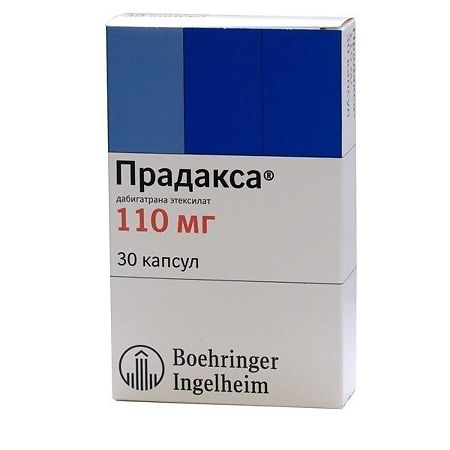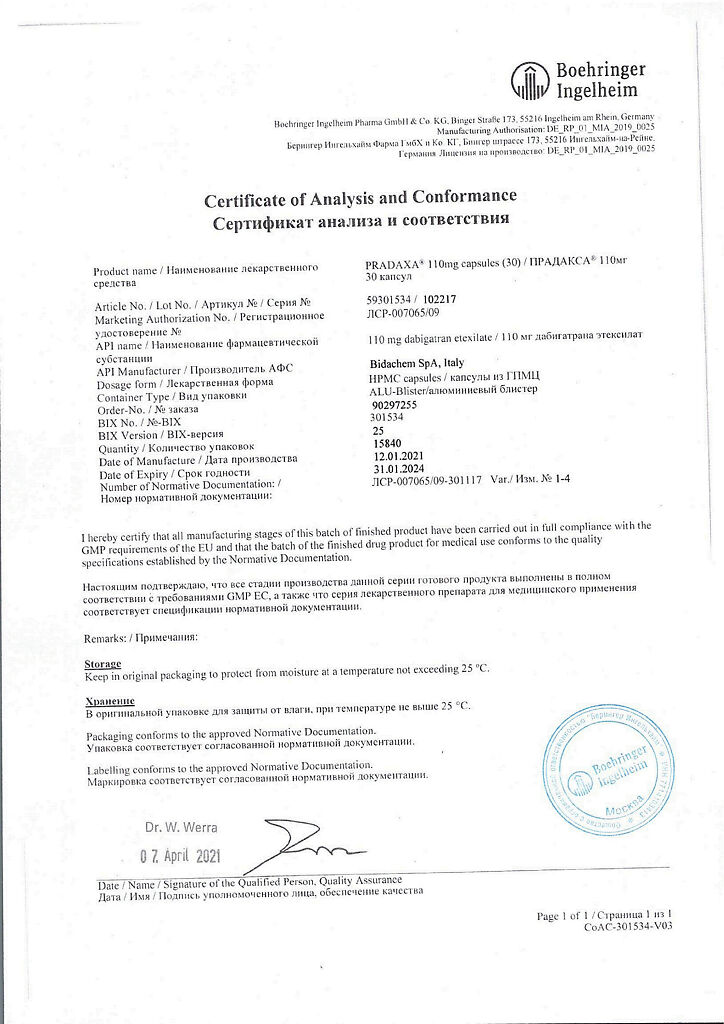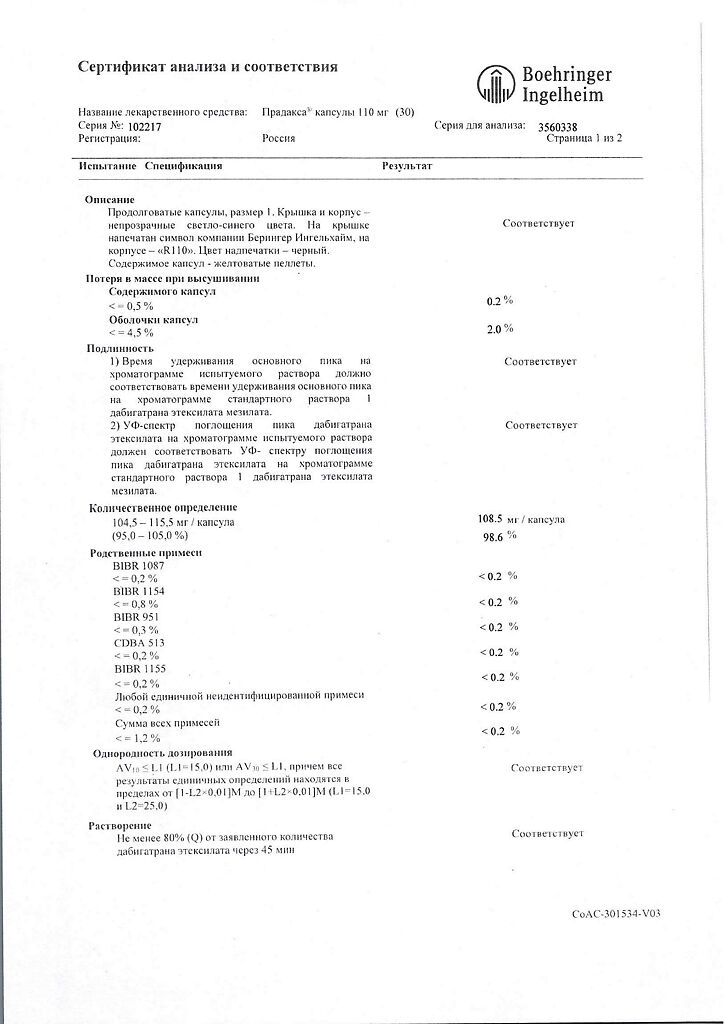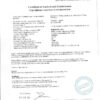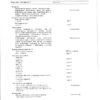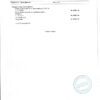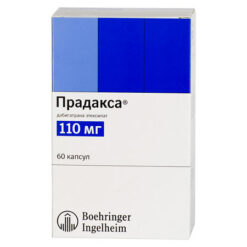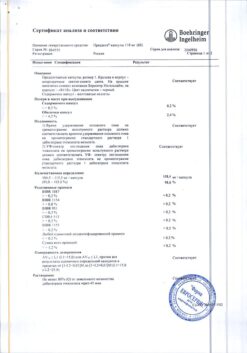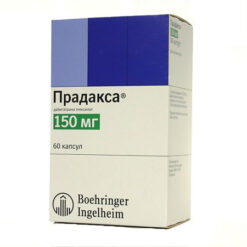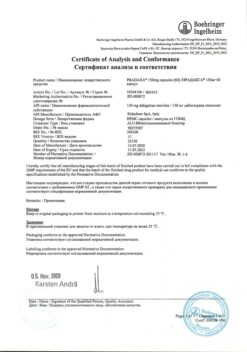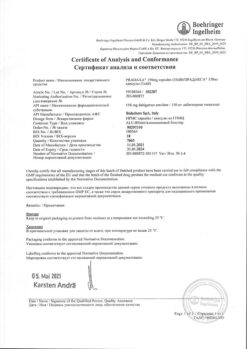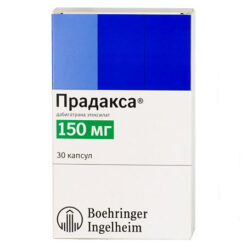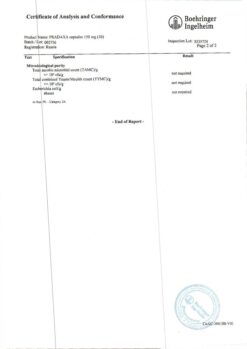No products in the cart.
Pradaxa, 110 mg capsules 30 pcs
€57.52 €47.93
Description
Pradaxa has an anticoagulant effect.
Pharmacodynamics
Dabigatran etexilate is a low molecular weight, nonpharmacologically active precursor form of dabigatran. After oral administration, dabigatran etexilate is rapidly absorbed in the gastrointestinal (GI) tract and, by esterase-catalyzed hydrolysis, is converted to dabigatran in the liver and blood plasma. Dabigatran is a potent competitive reversible direct thrombin inhibitor and the main active substance in blood plasma.
Because thrombin (a serine protease) converts fibrinogen into fibrin during coagulation, inhibition of thrombin activity prevents thrombus formation. Dabigatran has an inhibitory effect on free thrombin, thrombin associated with fibrin clot, and thrombin-induced platelet aggregation.
The antithrombotic effect and anticoagulant activity of dabigatran after intravenous administration and of dabigatran etexilate after oral administration have been confirmed in experimental studies in various models of thrombosis in vivo and ex vivo.
The direct correlation between the plasma concentration of dabigatran and the severity of the anticoagulant effect has been established. Dabigatran prolongs activated partial thromboplastin time (APTT), ekarin clotting time (EVT), and thrombin time (TT).
Prevention of venous thromboembolism (VTE) after arthroplasty of major joints
. Results of clinical studies in patients, orthopaedic surgery – knee and hip arthroplasty – have confirmed the preservation of hemostasis parameters and the equivalence of dabigatran etexilate 75 mg or 110 mg 1-4 hours after surgery and a subsequent maintenance dose of 150 or 220 mg once daily for 6-10 days (for knee surgery) and 28-35 days (for hip surgery) compared to enoxaparin at a dose of 40 mg once daily, which was used the day before and after surgery.
The equivalence of the antithrombotic effect of dabigatran etexilate at 150 mg or 220 mg compared with enoxaparin at a dose of 40 mg daily was shown when assessing the primary endpoint, which included all venous thromboembolic events and all-cause mortality.
Prevention of stroke and systemic thromboembolism in patients with atrial fibrillation
. In long-term use, averaging about 20 months in patients with atrial fibrillation and at moderate to high risk of stroke or systemic thromboembolism, dabigatran etexilate at a dose of 110 mg twice daily was shown to be as effective as warfarin in preventing stroke and systemic thromboembolism in patients with atrial fibrillation; as in the dabigatran group, a decrease in the risk of intracranial bleeding and overall bleeding rate was also noted. Administration of higher dose of drug (150 mg 2 times per day) significantly reduced the risk of ischemic and hemorrhagic strokes, cardiovascular death, intracranial bleeding and overall bleeding rate compared to warfarin. The lower dose of dabigatran was characterized by a significantly lower risk of major bleeding compared with warfarin.
The net clinical effect was assessed by determining a combined endpoint that included the incidence of stroke, systemic thromboembolism, pulmonary embolism, acute myocardial infarction, cardiovascular mortality and major bleeding.
The annual incidence of these events was lower in patients receiving dabigatran etexilate than in patients receiving warfarin.
Changes in laboratory measures of liver function in patients receiving dabigatran etexilat were of comparable or lower frequency compared with patients receiving warfarin.
Pharmacokinetics
After oral administration of dabigatran etexilate there is a rapid dose-dependent increase in its plasma concentration and area under the concentration-time curve (AUC). Maximum concentration of dabigatran etexilate (Cmax) is reached within 0.5-2 hours.
After reaching Cmax plasma concentrations of dabigatran decrease biexponentially, the final elimination half-life (T1/2) averages about 11 h (in the elderly). The final T1/2 after multiple administration of the drug was about 12-14 h. T1/2 is independent of the dose. However, in case of impaired renal function the T1/2 is prolonged.
The absolute bioavailability of dabigatran after oral dabigatran etexilate in hypromellose capsules is approximately 6.5%.
Eating does not affect the bioavailability of dabigatran etexilate, but the time to reach Cmax increases by 2 h.
When dabigatran etexilate is used without the special capsule shell made of hypromellose, the bioavailability when taken orally may increase by approximately 1.8 times (75%) compared to the capsule dosage form. Therefore, the integrity of hypromellose capsules should be maintained, given the risk of increased bioavailability of dabigatran etexilate, and it is not recommended to open the capsules and use their contents in their pure form (e.g. by adding to food or drinks) (see section “Dosage and administration”).
When dabigatran etexilate is administered 1-3 h in patients after surgical treatment, a decrease in the rate of absorption of the drug compared to healthy volunteers is noted. AUC is characterized by a gradual increase in amplitude without the appearance of a high peak plasma concentration. Cmax in plasma is noted 6 h after dabigatran etexilate administration or 7-9 h after surgery. It should be noted that factors such as anesthesia, gastrointestinal paresis and surgery may be important in slowing absorption, regardless of the dosage form of the drug. A decrease in the rate of drug absorption is usually noted only on the day of surgery. On subsequent days, absorption of dabigatran is rapid, with Cmax reaching 2 h after oral administration.
Metabolism
After oral administration during hydrolysis under the influence of dabigatran esterase, etexilate is rapidly and completely converted to dabigatran, which is the main active metabolite in blood plasma. Conjugation of dabigatran produces 4 isomers of pharmacologically active acylglucuronides: 1-O, 2-O, 3-O, 4-O, each of which is less than 10% of the total dabigatran in blood plasma. Traces of other metabolites are detectable only with highly sensitive analytical methods.
Distribution
The volume of distribution of dabigatran is 60-70 liters and exceeds the volume of total body water, indicating a moderate distribution of dabigatran in tissues.
Excretion
Dabigatran is excreted unchanged, mainly by the kidneys (85%), and only 6% through the gastrointestinal tract. It has been found that 88-94% of the labeled radioactive drug dose is eliminated from the body 168 h after administration.
Dabigatran has a low capacity of binding to plasma proteins (34-35%); it does not depend on the concentration of the drug.
Particular groups of patients
Elderly patients
. In elderly persons, the AUC value is 1.4-1.6 times higher than in younger persons (by 40-60%) and the Cmax is more than 1.25 times higher (by 25%).
The observed changes correlated with an age-related decrease in creatinine clearance (CC).
In elderly women (over 65 years of age), the AUCτ,ss and Cmax,ss were approximately 1.9-fold and 1.6-fold higher than in younger women (18-40 years old), and 2.2-fold and 2.0-fold higher in older men than in younger men. In a study in patients with atrial fibrillation, the effect of age on dabigatran exposure was confirmed: Dabigatran baseline concentrations were approximately 1.3-fold (31%) higher in patients aged ≥75 years, and in patients aged
Disordered renal function
In volunteers with moderate renal function impairment (CK – 30-50 mL/min), the AUC of dabigatran after oral administration was approximately 3-fold higher than in those with unchanged renal function.
In patients with severe renal impairment (CK – 10-30 ml/min) the AUC values of dabigatran etexilate and T1/2 increased by 6 and 2 times, respectively, compared to the same values in persons without renal impairment.
In patients with atrial fibrillation and moderate renal impairment (CK 30-50 ml/min), dabigatran concentrations before and after drug administration were on average 2.29 and 1.81 times higher than in patients without renal impairment.
When hemodialysis was used in patients without atrial fibrillation, it was found that the amount of drug excreted was proportional to the blood flow rate. The duration of dialysis, with a dialysate flow rate of 700 mL/min, was 4 hours and the blood flow rate was 200 mL/min or 350-390 mL/min. This resulted in removal of 50% and 60% of free and total dabigatran concentrations, respectively. The anticoagulant activity of dabigatran decreased as plasma concentrations decreased; the relationship of FC and FD did not change.
Hepatic impairment
There were no changes in plasma concentrations of dabigatran in patients with moderate hepatic impairment (Child-Pugh score 7-9) compared to patients without hepatic impairment.
Body weight
In studies, basal concentrations of dabigatran in patients with a body weight of >100 kg were approximately 20% lower than in patients with a body weight of 50-100 kg. The majority (80.8%) of patients had a body weight of ≥50 to <100 kg; no clear differences in dabigatran concentrations were found within this range. Data are limited for patients with a body weight ≤50 kg.
Per sex
In major studies on the prevention of VTE, exposure to the drug was found to be approximately 1.4-1.5 times (40-50%) higher in female patients. In patients with atrial fibrillation, basal concentrations and concentrations after drug administration were on average 1.3 (by 30%) higher. The established differences had no clinical significance.
Ethnic Groups
In a comparative study of the pharmacokinetics of dabigatran in Europeans and Japanese after a single and repeated administration of the drug, no clinically significant differences were found in the ethnic groups studied. Pharmacokinetic studies in patients of the Negro race are limited, but available data indicate no significant differences.
Indications
Indications
Prevention of venous thromboembolism in patients after orthopedic surgery; prevention of stroke, systemic thromboembolism and reduction of cardiovascular mortality in patients with atrial fibrillation.
Active ingredient
Active ingredient
Composition
Composition
Active ingredient:
dabigatran etexilate mesylate;
Auxiliary substances:
Acacia gum;
tartaric acid coarse-grained;
tartaric acid powder;
tartaric acid crystalline;
Hypromellose;
dimethicone;
Talc;
Hyprolose (hydroxypropyl cellulose);
Shell:
Hypromellose capsule (HPMC) overprinted with black ink (Colorcon S-1-27797);
The HPMC capsules:
carrageenan; potassium chloride; titanium dioxide; indigo carmine (E132); sunset yellow dye (E110); Hypromellose (hydroxypropyl methylcellulose), purified water;
Content of black ink Colorcon S-1-27797, (%, wt.):
shellac 52.500%, butanol 6.550%, purified water 1.940%, denatured ethanol (methylated alcohol) 0.650%, iron oxide black dye (E172) 33.770%, isopropanol 3.340%, propylene glycol 1.250%
How to take, the dosage
How to take, the dosage
The capsules should be taken orally, once or twice a day, regardless of the time of the meal, with water. The capsule should not be opened.
Interaction
Interaction
The co-administration of PRADAXA with drugs affecting hemostasis or the coagulation system, including vitamin K antagonists, may significantly increase the risk of bleeding.
Pharmacokinetic interactions
In in vitro studies, no inducing or inhibitory effect of dabigatran on cytochrome P450 was found. In in vivo studies in healthy volunteers, no interaction was observed between dabigatran etexilate and atorvastatin (CYP3A4 substrate) and diclofenac (CYP2C9 substrate).
Interactions with P-glycoprotein inhibitors/inducers:
The substrate for the transport molecule of P-glycoprotein is dabigatran etexilate. Concomitant use of P-glycoprotein inhibitors (amiodarone, verapamil, quinidine, ketoconazole for systemic use or clarithromycin) leads to increased plasma concentrations of dabigatran.
Concomitant use with P-glycoprotein inhibitors:
Dose adjustment is not required when using the listed P-glycoprotein inhibitors for prevention of stroke, systemic thromboembolism and reduction of cardiovascular mortality in patients with atrial fibrillation.
When used for prophylaxis of venous thromboembolism in patients after orthopedic surgery, see sections “Administration and Dose” and “Interaction with Other Medications”.
Amiodarone. When dabigatran etexilate was used concomitantly with a single dose of amiodarone (600 mg) taken orally, the degree and rate of absorption of amiodarone and its active metabolite, desethylamiodarone, did not change. The AUC and Cmax values of dabigatran increased approximately 1.6 and 1.5-fold (60% and 50%), respectively.
In the study in patients with atrial fibrillation, dabigatran concentrations were increased by no more than 14% and no increase in bleeding risk was reported.
Dronedarone. After concomitant administration of dabigatran etexilate and dronedarone at a dose of 400 mg once,
The AUC0-â and Cmax of dabigatran increased 2.1 and 19 times (by 114% and 87%), respectively, and 2.4 and 2.3 times (by 136% and 125%), respectively, after multiple dronedarone doses of 400 mg per day. The AUC0-â increased 1.3 and 1.6-fold, respectively, after single and multiple dronedarone administration 2 hours after dabigatran etexilate administration. Dronedarone had no effect on the final T1/2 and renal clearance of dabigatran.
Verapamil. When dabigatran etexilate was used concomitantly with orally administered verapamil, the Cmax and AUC values of dabigatran were increased depending on the time of administration and the dosage form of verapamil.
The greatest increase in the effect of dabigatran was observed with the first dose of verapamil in immediate-release dosage form administered 1 h before dabigatran etexilate (Cmax increased by 180% and AUC increased by 150%). This effect was progressively reduced with the delayed-release dosage form verapamil (Cmax increased by 90% and AUC increased by 70%), as well as with multiple doses of verapamil (Cmax increased by 60% and AUC increased by 50%), which may be due to induction of P-glycoprotein in the GI tract with long-term verapamil administration.
When using verapamil 2 h after dabigatran etexilate administration, no clinically significant interactions were observed (Cmax increased by 10% and AUC increased by 20%) because dabigatran is fully absorbed after 2 h (see section “Dosage and administration”).
In the study in patients with atrial fibrillation the concentration of dabigatran did not increase by more than 21%, no increased risk of bleeding was registered.
There are no data on interactions of dabigatran etexilate with parenterally administered verapamil; no clinically significant interaction is expected.
Ketoconazole. Ketoconazole for systemic use increases the AUC0-â and Cmax of dabigatran by approximately 2.4-fold (by 138% and 135%), respectively, and by approximately 2.5-fold (by 153% and 149%) after a single 400-mg daily dose of ketoconazole, respectively. Ketoconazole had no effect on Tmax and final T1/2. Simultaneous use of PRADAXA and ketoconazole for systemic use is contraindicated.
Clarithromycin. No clinically significant pharmacokinetic interaction was observed with dabigatran etexilate when clarithromycin was used concomitantly at a dose of 500 mg twice daily (Cmax increased by 15% and AUC increased by 19%).
Hinidine. The AUCÏ,ss and Cmax,ss values of dabigatran when administered 2 times daily when concomitantly with quinidine at a dose of 200 mg every 2 hours until the total dose of 1000 mg was increased by 53% and 56% on average, respectively.
Concomitant use with substrates for P-glycoprotein:
Digoxin. No pharmacokinetic interaction has been observed when dabigatran etexilate is used concomitantly with digoxin, which is a P-glycoprotein substrate. Neither dabigatran nor the prodrug dabigatran etexilate are clinically significant inhibitors of P-glycoprotein.
Simultaneous use with P-glycoprotein inducers:
The simultaneous administration of PRADAXA and P-glycoprotein inducers should be avoided because co-administration results in decreased effect of dabigatran (see section “Special Precautions”).
Rifampicin. Pre-administration of the test inducer rifampicin at a dose of 600 mg daily for 7 days resulted in decreased exposure to dabigatran. After withdrawal of rifampicin, this inductive effect decreased, with the dabigatran effect close to baseline on day 7. No further increase in dabigatran bioavailability was observed over the next 7 days.
It has been suggested that other P-glycoprotein inducers, such as St. John’s wort or carbamazepine, may also decrease plasma concentrations of dabigatran and should be used with caution.
Simultaneous use with antiaggregants
Acetylsalicylic acid (ASA). In a study of concomitant use of dabigatran etexilate at a dose of 150 mg twice daily and acetylsalicylic acid (ASA) in patients with atrial fibrillation, it was found that the risk of bleeding may increase from 12% to 18% (when using ASA at a dose of 81 mg) and up to 24% (when using ASA at a dose of 325 mg). It has been shown that ASA or clopidogrel used concomitantly with dabigatran etexilate at a dose of 110 mg or 150 mg twice daily may increase the risk of major bleeding. Bleeding is observed more often also when concomitant use of warfarin with ASA or clopidogrel.
NSAIDs. NSAIDs (nonsteroidal anti-inflammatory drugs) used for short-term analgesia after surgery did not increase the risk of bleeding when used concomitantly with dabigatran etexilate. There is limited experience with long-term use of NSAIDs with a T1/2 of less than 12 hours with dabigatran etexilate and no evidence of an additional increased risk of bleeding.
Clopidogrel. Concomitant use of dabigatran etexilate and clopidogrel has not been shown to result in an additional increase in capillary bleeding time compared with clopidogrel monotherapy. In addition, the AUCÏ,ss and Cmax,ss values have been shown dabigatran, as well as clotting parameters that were monitored to assess the effect of dabigatran (aChTV, ecarinic clotting time or thrombin time (anti FIIa), as well as the degree of inhibition of platelet aggregation (the main indicator of clopidogrel effect) during combination therapy were not changed compared with the corresponding values in monotherapy. When using a “loading” dose of clopidogrel (300 or 600 mg), the AUCt,ss and Cmax,ss values of dabigatran were increased by 30-40%.
Concomitant use with drugs that increase the pH of the stomach contents
Pantoprazole. When dabigatran etexilate and pantoprazole are used together, a 30% decrease in the AUC of dabigatran was observed. Pantoprazole and other proton pump inhibitors have been used together with dabigatran etexilate in clinical trials, no effect on bleeding risk or efficacy has been observed.
Ranitidine. When used concomitantly with dabigatran etexilate, ranitidine had no significant effect on the degree of absorption of dabigatran.
The changes in pharmacokinetic parameters of dabigatran under the influence of proton pump inhibitors and antacid drugs revealed in the population analysis were clinically insignificant, because the degree of severity of these changes was small (the decrease in bioavailability was not significant for antacids, and for proton pump inhibitors it was 14.6%). It was found that concomitant use of proton pump inhibitors is not accompanied by a decrease in dabigatran concentration and, on average, only slightly reduces the concentration of the drug in blood plasma (by 11%). Therefore, concomitant use of proton pump inhibitors does not appear to increase the incidence of stroke or systemic thromboembolism, especially in comparison with warfarin, and, therefore, the decrease in dabigatran bioavailability caused by concomitant use of pantoprazole is probably not clinically significant.
Contraindications
Contraindications
Side effects
Side effects
Hematopoietic and lymphatic system disorders: anemia, thrombocytopenia.
Immune system disorders: hypersensitivity reactions, including urticaria, rash and itching, bronchospasm.
Nervous system disorders: intracranial bleeding.
vascular disorders: hematoma, bleeding.
Respiratory, chest and mediastinal disorders: nasal bleeding, hemoptysis.
Gastrointestinal disorders: gastrointestinal bleeding, rectal bleeding, hemorrhoidal bleeding, abdominal pain, diarrhea, dyspepsia, nausea, ulceration of mucosa of the gastrointestinal tract, gastroesophagitis, gastroesophageal reflux disease, vomiting, dysphagia.
Hepatobiliary system disorders: increased “liver” transaminases activity, liver dysfunction, hyperbilirubinemia.
Skin and subcutaneous tissue changes: skin hemorrhagic syndrome.
Skeletal and muscular disorders, connective tissue and bone disorders: hemarthrosis.
Kidney and urinary tract changes: urogenital bleeding, hematuria.
General disorders and changes at the injection site: bleeding from the injection site, bleeding from the site of catheter insertion.
Damage, toxicity and complications from procedures: post-traumatic hematoma, bleeding from the site of surgical access.
Vascular disorders: bleeding from the surgical wound.
General disorders and disorders at the site of administration: bloody discharge.
Damage, toxicity and complications of postoperative treatment: hematoma after wound care, bleeding after wound care, anemia in the postoperative period, discharge from the wound after procedures, wound secretions.
Surgical and therapeutic procedures: wound drainage, drainage after wound care.
Overdose
Overdose
Overdose when using PRADAXA may be accompanied by hemorrhagic complications due to the pharmacodynamic characteristics of the drug. In case of bleeding discontinue the use of the drug. Symptomatic treatment is indicated. There is no specific antidote.
Given the main route of dabigatran excretion (by the kidneys), it is recommended to ensure adequate diuresis. Surgical hemostasis and replenishment of circulating blood volume (RBC) are performed. Fresh whole blood or fresh frozen plasma transfusion is possible. Since dabigatran has low plasma protein binding capacity, the drug may be excreted by hemodialysis, but clinical experience with the use of dialysis in these situations is limited (see section “Pharmacokinetics”).
In case of an overdose of PRADAXA, activated prothrombin complex or recombinant factor VIIa concentrates or concentrates of II, IX or X clotting factors may be used. There is experimental evidence to support the effectiveness of these agents in counteracting the anticoagulant effect of dabigatran, but no specific clinical studies have been conducted.
If thrombocytopenia develops, or if long-acting antiaggregants are used, platelet mass may be considered.
Additional information
| Shelf life | 3 years |
|---|---|
| Conditions of storage | In a dry place, at a temperature not exceeding 25 °C |
| Manufacturer | Boehringer Ingelheim Pharma GmbH & Co. |
| Medication form | capsules |
| Brand | #Н/Д |
Other forms…
Related products
Buy Pradaxa, 110 mg capsules 30 pcs with delivery to USA, UK, Europe and over 120 other countries.

